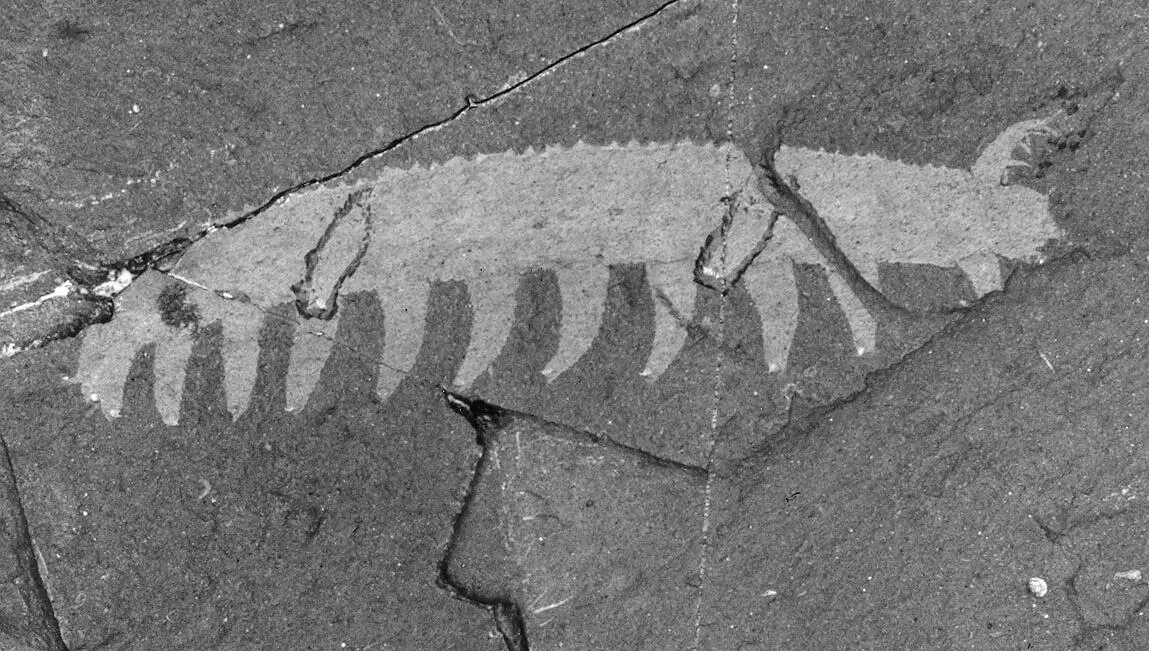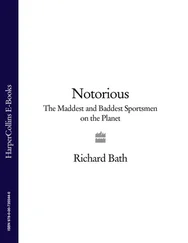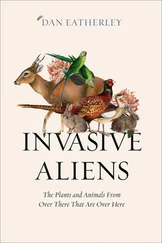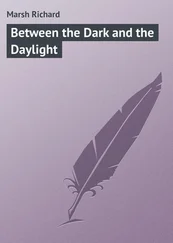
4. Cambrian lobopod fossil Aysheaia pedunculata from the Burgess Shale in the Canadian Rockies, British Columbia.
Comparing Aysheaia with Peripatus reveals that they are of similar size and shape, the former reaching about six cm in length. The fact that differently sized animals of Aysheaia retain the same form as they get larger, implies a simple growth pattern like that of the modern velvet worms. In Aysheaia the fine rings encircling the body are clearly visible, and little prickles are much like the papillae of the living animal; add to that their stumpy conical legs look very alike, and at the tips in the fossil little sickle-like claws can be clearly seen. But there are some differences between this most ancient animal and the creature I helped to dig out of its woody habitat – it would have been astonishing if there were not. Most obviously, there is a pair of gill-like structures on the head end of the fossil. This is hardly surprising since the animal was living under water. There is also no sign of the special slime glands in the fossil. This must have been a later development, which presumably would also have been acquired after the terrestrial invasion. But it would take a hardened sceptic not to believe that these animals were related. Of course in science there are always such sceptics, and the special features of Aysheaia were emphasised by some at the expense of its many similarities to Peripatus, but I believe most students today would accept the onychophoran tag on the Cambrian creature.
The story got interesting when a second, and much more peculiar-looking Burgess Shale species was assigned to the onychophorans. This animal had been named in 1977 Hallucigenia by the Cambridge palaeontologist Simon Conway Morris, but his original description of the fossil was upside down. Hallucigenia carried paired spikes on its back which Conway Morris had originally interpreted as legs (he later acknowledged his error with good grace), while the true legs were more spindly affairs than those of living velvet worms or, indeed, Aysheaia. The spines arose from hardened plates, which had been found separately as fossils in early Cambrian strata, but had been unfathomable up to that time. The mystery was not fully elucidated until much better preserved, soft-bodied fossils began to be found over the last decade or so in strata cropping out around Chengjiang in Yunnan Province in China (these are known as the shales of the Maotianshan Formation). The new fossils were up to ten million years older than the Burgess Shale examples, and have now proved even more diverse. They include at least six animals that can be assigned to the same group as the velvet worms. One of them carries spikes on its back and was an additional species of Hallucigenia, another one (Paucipodia) was an altogether slimmer affair than its distant living relatives, with only nine pairs of slender legs. One fact was now becoming clear: the relatives of the velvet worm were much more varied in the early days. There were lots of them of several distinct kinds, but they did all share those lobe-like legs, often tipped by little claws. An appropriate term for the whole group, both living and fossil, achieved wide currency during the 1990s – they were ‘lobopods’. Thanks to the special preservation of these Cambrian fossils it was possible to see surprisingly varied and delicate lobopod animals in unprecedented detail. Living velvet worms began to seem more of an evolutionary afterthought.
The plot thickened still further at this time, for up in Greenland Dr Graham Budd and his colleagues were finding yet more soft-bodied animals in the early Cambrian Buen Formation. These showed certain similarities to onychophorans, like the rings along the body, but the animal named Kerygmachela by Budd had a pair of grasping appendages at the front and was obviously a hunter capable of grasping prey. The lobopods were clearly going to spring yet more surprises.
The question now arises as to where this curious bunch of animals fits in on the tree of life. I have already described how Cambrian fossil faunas included many kinds of jointed-legged animals or arthropods, such as distant relatives of the horseshoe crab. All these arthropods would have had a tough chitin covering over the body that made the ‘invention’ of hinged joints necessary. Without them, the animals would have been as helpless as a medieval jouster whose articulated armour had rusted into immobility. But with hinges added, arthropods were equipped with a versatile covering that could be recruited to be armour, jaws or toolkit as the occasion demanded. The future walked on spindly legs. Like arthropods, velvet worms and their relatives were, and are, segmented animals. Unlike arthropods they did not have a strong coat made of chitin: no hinges were possible. Their lobopod legs were effective enough in their own plodding way, but they could not be extended into the attenuated pins of a daddy-long-legs. That requires serious mechanical engineering, and the stiffening support of a hard skeleton. On the other hand, some features of internal anatomy seem to be very similar between living onychoporans and arthropods. I could mention the diffuse circulation system and the arrangement of the nerve cords, and some scientists are impressed by the presence of antennae in both kinds of organisms. At least one of the Cambrian lobopods shows evidence of simple eyes. The musculature is differently arranged in lobopods and arthropods, which actually allows the lobopods greater bodily flexibility.
Their fundamental similarities make it likely that Peripatus and arthropods share a common ancestor. The arthropods seem to be more advanced in several respects: the jointed legs could only have been added when the ‘skin’ acquired its hard outer layer, and sophisticated compound eyes like those of Limulus must surely have been a later development. This is another way of saying that lobopods are probably sited on a lower level on the great tree of life, likely to have been around before the arthropods evolved. There are some scientists who would claim that they are the true ancestors of the arthropods, or even that different kinds of lobopod gave rise to different kinds of arthropods. Partly, this depends on the interpretation of the jawed animal Kerygmachela from Greenland that seems to display something of an amalgam of lobopod and arthropod characteristics. Whatever the final interpretation, these recent discoveries of Cambrian fossils provide another case of neat categories of animal classification blurring at the time of the ‘explosive’ phase of animal evolution. The story also takes us back further in time than we have been before.
Recently, additional evidence for the velvet worm’s place on the tree of life has come from the genome of the living species. Ancient fossils do not preserve DNA, which is a large and delicate molecule, readily fracturing into pieces. But by studying the molecules of living survivors from deep branches in the tree of life we are afforded a kind of telescope to see back in time. For the genetic code of DNA records another kind of history, it retains the accumulated narrative of all the changes at the fundamental molecular level that have built up slowly over time. Mutations that have been incorporated in the genome provide a kind of ancient fingerprint. But the code of life is famously huge – which means that the investigator may be obliged to seek out the particular piece of the genome that contains the information he needs. Although, as this is written, more and more organisms are having their entire DNA sequenced, this is still the prerogative of a privileged few – unsurprisingly, those like wheat or influenza that have a particular importance to Homo sapiens. For many organisms, it is more feasible to use a particular chunk of its genetic code to compare with the same chunk from a range of its potential relatives. This might be a particularly suitable gene or series of genes, for example, that do not change too rapidly to be useful through long periods of geological time. Obviously, the chosen gene has to be present in all the organisms under study. Other workers favour sequencing parts of the RNA molecule in the ribosomes that are present in the cells of all living organisms as the centres for protein synthesis. Comparing the similarity of gene sequences is one way assessing how closely (or not) organisms are related to one another. The results can be drawn up as another kind of tree, with branches drawing together the closest related species, and deeper patterns of branching inferred from still more fundamental inherited similarities. This is not as easy as it might sound from this bald description, as various kinds of ‘noise’ can obscure the signal the investigator seeks, and there are always genes that change too fast to retain meaningful signals from deep time. I need hardly add that computer programs have been designed to help out. The technical problems are not part of our story, except in so far as they have produced different ‘trees’ of relationships between organisms since the methods were first developed. Indeed, early attempts sometimes look quaint or improbable. But recent studies seem to have stabilised, and produce trees that appeal to prior knowledge and common sense, mostly by lumping together evidence from many different genes and finding the best fit. These then make a meaningful contribution to the summary trees of evolutionary history like those on our endpapers. The latest molecular analyses to treat the velvet worm and its relatives show interesting results. It places our chosen survivor as the bottom branch of a tree that includes all the arthropods above it – which must therefore have arrived later. Another name appears between the lobopods and the arthropods. This is Tardigrada (water bears), a group of tiny creatures that often live between sand grains and in other cryptic habitats. They are interesting in their own right, but they have but one known fossil, so they will not be described in detail here. Many tiny animals have no fossil record at all, but that does not mean that they did not exist in the past. The important point for us is that the molecular evidence supports the idea that lobopods are a branch even lower on the tree of life than arthropods. Those stumpy legs have walked on and on from a time even before the Cambrian. The very earliest Cambrian strata contain the traces of animals, but not their bodies. This is probably because those early animals lacked readily fossilisable hard parts, and the special conditions required to preserve the slightly younger Chengjiang fossils were not present at this particular time. No matter, for some of the tracks and trails that are preserved as fossils show clearly the traces made by arthropods of normal size digging their way into soft sediments with their numerous paired legs. It is even possible that these could have been tracks left behind by soft-bodied ‘proto’ trilobites since they are similar to tracks made by the same animals higher in the geological column; at the moment we simply do not know. But we now do know that there must have been lobopods on that same sea floor, too, stomping ever onwards. More than that, they must have been present even earlier, before the first arthropods, because both the molecules and the anatomy of the animals tell us that they preceded the jointed-legged organisms. This takes us back into the mysterious world of the Ediacaran, a period whose remains lie above the Precambrian, and below the Cambrian, before the time of abundance and variety of marine life and before the appearance of shells. *
Читать дальше













